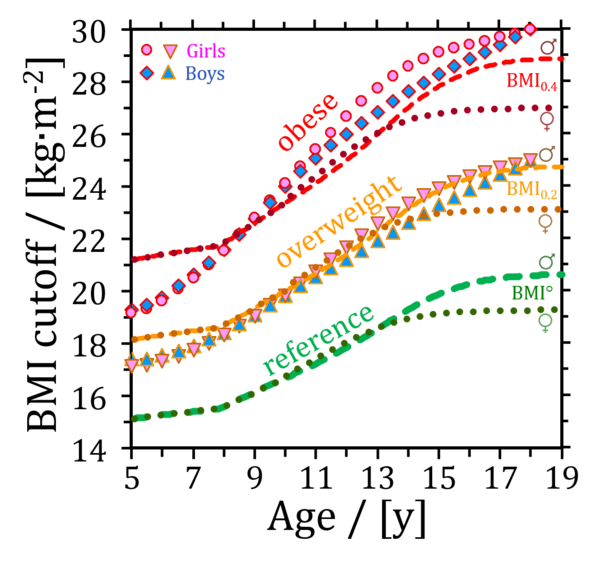Cole 2000 BMJ
| Cole TJ, Bellizzi MC, Flegal KM, Dietz WH (2000) Establishing a standard definition for child overweight and obesity worldwide: international survey. BMJ 320:1240-3. |
Cole TJ, Bellizzi MC, Flegal KM, Dietz WH (2000) BMJ
Abstract: OBJECTIVE: To develop an internationally acceptable definition of child overweight and obesity, specifying the measurement, the reference population, and the age and sex specific cut off points.
DESIGN: International survey of six large nationally representative cross sectional growth studies.
SETTING: Brazil, Great Britain, Hong Kong, the Netherlands, Singapore, and the United States.
SUBJECTS: 97 876 males and 94 851 females from birth to 25 years of age.
MAIN OUTCOME MEASURE: Body mass index (weight/height(2)).
RESULTS: For each of the surveys, centile curves were drawn that at age 18 years passed through the widely used cut off points of 25 and 30 kg/m(2) for adult overweight and obesity. The resulting curves were averaged to provide age and sex specific cut off points from 2-18 years.
CONCLUSIONS: The proposed cut off points, which are less arbitrary and more internationally based than current alternatives, should help to provide internationally comparable prevalence rates of overweight and obesity in children.
PIP: This study aimed to develop an internationally acceptable definition of child overweight and obesity, specifying the measurement, reference population, and age and sex specific cut off points. Data on body mass index (weight/height) were obtained from 6 large nationally representative cross sectional surveys on growth from Brazil, Great Britain, Hong Kong, the Netherlands, Singapore, and the US. The study included 97,876 males and 94,851 females from birth to 25 years of age. For each of the surveys, centile curves were drawn that at age 18 years passed through the widely used cut-off points of 25 and 30 kg/sq. m for adult weight and obesity. The resulting curves were averaged to provide age- and sex-specific cut-off points from 2 to 18 years. The proposed cut off points, which are less arbitrary and more internationally based than current alternatives, should help to provide internationally comparable prevalence rates of overweight and obesity in children.
• Bioblast editor: Gnaiger E
From BMI to BME
- The concept of the healthy reference population (HRP) and body mass excess relates the actual body mass, M, to the reference body mass, M°, at any given height in the HRP. Cut-offs for overweight and obesity are at 1.2M° and 1.4M° or BME of 1.2 and 1.4, respectively. The BMI° of the HRP increases with height (see Body mass excess [2]). Up to 13 years, girls and boys have the same height [3, 4], and the BMI° increases from about 15 to 18 kg·m-2 from 5 to 13 years (Fig. 1). In the following years, boys continue to grow and BMI° continues to increase to 20.5 kg·m-2, whereas growth of girls ceases and their BMI° remains at about 19 kg·m-2. This pattern applies to the HRP.
The BMI cut-off values of Cole et al (2010) agree closely with the BMI cut-off values derived from the BME-concept between age 8 and 13 (Fig. 1). Cole et al (2010) use identical BMI cut-off values for women and men at the age of 18, 25 kg·m-2 for overweight and 30 kg·m-2 for obesity. This ignores the fact that (1) women are smaller than men (see Height of humans), and (2) the BMI increases with height independent of a trend towards overweight (see Body mass excess). This explains, why lower BMI cut-off values are predicted from the BME-concept for women than men (Fig. 1).
Below the age of 8 years, the allometric phase changes to different exponents in the HRP. This is ignored in the approach of Cole et al (2010), which explains why their suggested cut-off values continue to drop more steeply with diminishing age compared to the HRP and the corresponding BME-linked cut-off values of the BMI (Fig. 1).
References
- Cole TJ, Bellizzi MC, Flegal KM, Dietz WH (2000) Establishing a standard definition for child overweight and obesity worldwide: international survey. BMJ 320:1240-3.
- Body mass excess
- WHO Multicentre Growth Reference Study Group (2006) WHO child growth standards based on length/height, weight and age. Acta Pædiatrica Suppl 450:76-85.
- WHO Multicentre Growth Reference Study Group (2006) WHO child growth standards: length/height-for-age, weight-for-age, weight-for-length, weight-for-height and body mass index-for-age: Methods and development. Geneva: World Health Organization:312 pp.
Labels: MiParea: Gender, Developmental biology, Exercise physiology;nutrition;life style
Pathology: Obesity
Organism: Human
Preparation: Intact organism
BMI

